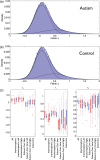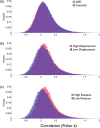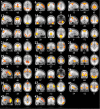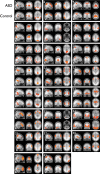Largely typical patterns of resting-state functional connectivity in high-functioning adults with autism
- PMID: 23425893
- PMCID: PMC4051895
- DOI: 10.1093/cercor/bht040
Largely typical patterns of resting-state functional connectivity in high-functioning adults with autism
Abstract
A leading hypothesis for the neural basis of autism postulates globally abnormal brain connectivity, yet the majority of studies report effects that are either very weak, inconsistent across studies, or explain results incompletely. Here we apply multiple analytical approaches to resting-state BOLD-fMRI data at the whole-brain level. Neurotypical and high-functioning adults with autism displayed very similar patterns and strengths of resting-state connectivity. We found only limited evidence in autism for abnormal resting-state connectivity at the regional level and no evidence for altered connectivity at the whole-brain level. Regional abnormalities in functional connectivity in autism spectrum disorder were primarily in the frontal and temporal cortices. Within these regions, functional connectivity with other brain regions was almost exclusively lower in the autism group. Further examination showed that even small amounts of head motion during scanning have large effects on functional connectivity measures and must be controlled carefully. Consequently, we suggest caution in the interpretation of apparent positive findings until all possible confounding effects can be ruled out. Additionally, we do not rule out the possibility that abnormal connectivity in autism is evident at the microstructural synaptic level, which may not be reflected sensitively in hemodynamic changes measured with BOLD-fMRI.
Keywords: autism spectrum disorder; functional magnetic resonance imaging; independent component analysis; resting-state networks; temporal correlation.
© The Author 2013. Published by Oxford University Press. All rights reserved. For Permissions, please e-mail: journals.permissions@oup.com.
Figures







References
-
- Abell F, Krams M, Ashburner J, Passingham R, Friston K, Frackowiak R, Happe F, Frith C, Frith U. The neuroanatomy of autism: a voxel-based whole brain analysis of structural scans. Neuroreport. 1999;10:1647–1651. - PubMed
-
- Andersson JL, Smith S, Jenkinson M. FNIRT–FMRIB non-linear image registration tool. 14th Annual Meeting of the Organization for Human Brain Mapping; Melbourne, Australia. 2008. p. 496.
Publication types
MeSH terms
Substances
Grants and funding
LinkOut - more resources
Full Text Sources
Other Literature Sources

